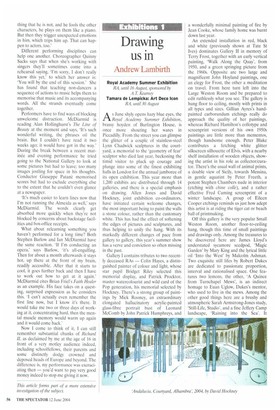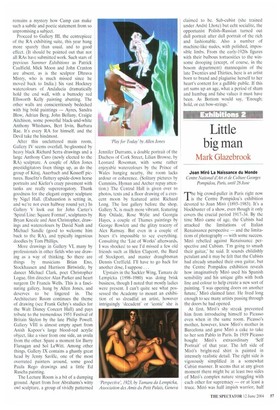Drawing us in
Andrew Lambirth
Royal Academy Summer Exhibition RA, until lb August, sponsored by AT Keamey Tamara de Lempicka: Art Deco Icon RA, until 30 August
s June shyly opens hazy blue eyes, the Royal Academy Summer Exhibition, brassy hoyden of Burlington House, is once more shouting her wares in Piccadilly. From the street you can glimpse the glitter of a couple of stainless-steel Lynn Chadwick sculptures in the courtyard, a memorial to the 'geometry of fear' sculptor who died last year, beckoning the timid visitor to pluck up courage and plunge into some of the finest exhibiting halls in London for the annual jamboree of its open exhibition. This year more than 1,200 exhibits are distributed through 14 galleries, and there is a special emphasis on drawing. Allen Jones and David Hockney, joint exhibition co-ordinators, have initiated certain welcome changes, the most important being to paint the walls a stone colour, rather than the customary white. This has had the effect of softening the edges of pictures and sculptures, and thus helping to unify the hang. With its markedly different changes of pace from gallery to gallery, this year's summer show has a verve and conviction so often missing in the past.
Gallery I contains tributes to two recently deceased RAs — Colin Hayes, a distinguished painter of colour and light, whose star pupil Bridget Riley selected this memorial display, and Patrick Procktor, master watercolourist and wild card of the Pop generation, his memorial selected by Hockney. There's a strong group of paintings by Mick Rooney, an extraordinary elongated hallucinatory acrylic-painted glass-fibre portrait bust of Leonard McComb by John Patrick Humphreys, and a wonderfully minimal painting of fire by Jean Cooke, whose family home was burnt down last year.
An extended installation in red, black and white (previously shown at Tate St Ives) dominates Gallery II in memory of Terry Frost, together with an early vertical painting, 'Walk Along the Quay', from 1950, and a green springing picture from the 1960s. Opposite are two large and magnificent John Hoyland paintings, one an elegy for Frost, the other a meditation on travel. From here turn left into the Large Weston Room and be prepared to edit ruthlessly what you see. The gallery is hung floor to ceiling, mostly with prints in all types and sizes. Gillian Ayres's handpainted carborundum etchings really do approach the quality of her paintings, whereas Richard Hamilton's collotype and screenprint versions of his own 1950s paintings are little more than mementos, though handsome enough. Peter Blake contributes a fetching white glitter silkscreen silhouette of Elvis, with a nearby shelf installation of wooden objects, showing the artist in his role as collector/curator. There's the usual wall of animal prints, a double view of Sicily, towards Messina, in gentle aquatint by Peter Freeth, a potent Stephen Chambers nude in interior (etching with chine colic), and a rather effective Fred Cuming screenprint of a winter landscape. A group of Eileen Cooper etchings reminds us just how adept this artist is at riding the tiger cat or beach ball of printmaking.
Off this gallery is the very popular Small Weston Room, another floor-to-ceiling hang, though this time of small paintings and drawings only. Among the treasures to be discovered here are James Lloyd's understated sycamore seedpod, 'Magic Garden' by Mary King and the lyrical little oil 'Into the West' by Malcolm Ashman. Two exquisite still Ides by Robert Dukes are dedicated to passionate proportion, interval and rationalised space. One features two lemons, the other, 'A Quince from Turnchapel Mews', is an indirect homage to Euan Uglow, Dukes's mentor, who used to live in the mews. Among the other good things here are a brushy and atmospheric Sarah Armstrong-Jones study, 'Still-Life, Studio', and a fine Jeffery Camp landscape, 'Raining into the Sea'. It remains a mystery how Camp can make such a subtle and poetic statement from so unpromising a subject.
Proceed to Gallery III, the centrepiece of the RA exhibiting suite, this year hung more sparely than usual, and to good effect. (It should be pointed out that not all RAs have submitted work. Such stars of previous Summer Exhibitions as Patrick Caulfield, Mick Moon and John Craxton are absent, as is the sculptor Dhruva Mistry, who is much missed since he moved back to India.) Six vast Hockney watercolours of Andalucia dramatically hold the end wall, with a buttocky red Ellsworth Kelly painting abutting. The other walls are conscientiously bedecked with big bold paintings — Ayres, Sandra Blow, Adrian Berg, John Bellany, Craigie Aitchison, some powerful black-and-white Anthony Whishaws, Bert Irvin, Barbara Rae. It's every RA for himself, and the Devil take the hindmost.
After this uncluttered main room, Gallery IV seems overfull. be-gloomed by heavy black Richard Serra drawings and a large Anthony Caro (newly elected to the RA) sculpture. A couple of Allen Jones prestidigitators liven things up, as do the group of Kitaj, Auerbach and Kossoff pictures. Baselitz's fluttery upside-down horse portraits and Kiefer's crazy pavement with tanks are really supererogatory. Thank goodness for the elegant copper sculpture by Nigel Hall. (Exhaustion is setting in, and we're not even halfway round yet.) In Gallery V look out for John Carter's 'Spiral Line: Square Format', sculptures by Bryan Kneale and Ann Christopher, drawings and watercolours by David Nash and Michael Sandie (good to welcome him back to the RA), and typically ingenious doodles by Tom Phillips, More drawings in Gallery VI, many by professionals in other fields who use draw ing as a way of thinking. So there are things by musicians Brian Eno, Stockhausen and Harrison Birtwistle, by dancer Michael Clark, poet Christopher Logue, film director Alan Parker and heart surgeon Dr Francis Wells. This is a fascinating gallery, hung by Allen Jones, and deserves to be lingered in. The Architecture Room continues the theme of drawing (see Frank Gehry's studies for the Walt Disney Concert Hall) and pays tribute to the tremendous 1951 Festival of Britain Skylon by the late Philip Powell, Gallery VIII is almost empty apart from Anish Kapoor's large blood-red acrylic object, like a visor from one side, an uvula from the other. Spare a moment for Barry Flanagan and Sol LeWitt. Among other things, Gallery IX contains a ghastly great head by Jenny Saville, one of the most overrated painters around, some good Paula Rego drawings and a little Ed Ruscha painting.
The Lecture Room is a bit of a dumping ground. Apart from Ivor Abrahams's witty owl sculpture, a group of vividly patterned Jennifer Durrants. a double portrait of the Duchess of Cork Street, Lilian Browse, by Leonard Rosoman, with some rather enjoyable watercolours by the Prince of Wales hanging nearby, the room lacks ardour or coherence. (Solitary pictures by Cummins, Hyman and Archer repay attention.) The Central Hall is given over to photos, texts and a floor drawing of a crescent moon by featured artist Richard Long. The last gallery before the shop, Gallery X, is much more vibrant. featuring Roy Oxlade, Rose Wylie and Georgia Hayes, a couple of Thames paintings by George Rowlett and the glitzy tracery of Alex Ramsay. But even in a couple of hours it's impossible to see everything. Consulting the 'List of Works' afterwards, I was shocked to see I'd missed a few old friends such as Helen Clapcott, the Bard of Stockport, and master draughtsman Dennis Creffield. I'll have to go back for another dose, I suppose.
Upstairs in the Sackler Wing, Tamara de Lempicka (1898-1980) was doing brisk business, though I noted that mostly ladies were present. I can't quite see what possessed the Academy to mount an exhibition of so dreadful an artist, however intriguingly 'decadent' or 'iconic' she is claimed to be. Sub-cubist (she trained under Andre Lhote) but echt socialite, the opportunist Polish–Russian turned out dull portrait after dull portrait of the rich and fashionable. Also a number of machine-like nudes, with polished, impossible limbs. From the early-1920s figures with their bulbous tortuosities to the winsome drooping (except, of course, in the bosom department) mannequins of the late Twenties and Thirties, here is an artist born to brand and plagiarise herself to her heart's content for a gullible public. If this art sums up an age, what a period of sham and humbug and false values it must have been. As Bottom would say, 'Enough; hold, or cut bow-strings.'



















































































 Previous page
Previous page